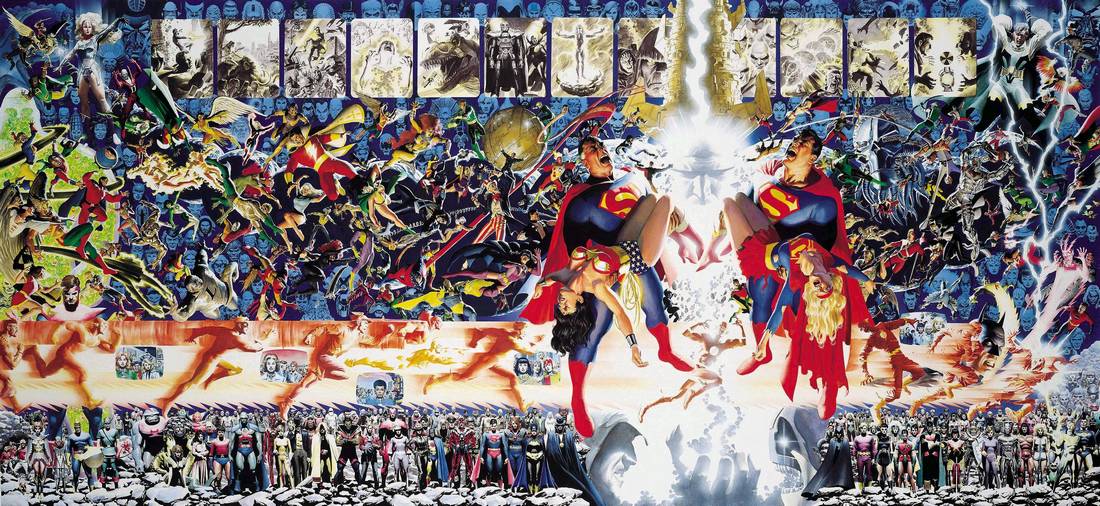“Crisis On Infinite Earth” (or, “Crisis” as it is often referred to) requires a familiarity with a certain amount of background material to completely appreciate. If you’re a new comics reader or had started reading comics in either the 1990s or 2000s, it would be a pretty confusing read, at least in trying to understand some of the supporting cast. Luckily, the ‘Absolute’ edition that I read contained a ‘compendium’ to assist.
According to that compendium, the series involved four years of intensive research by members of the DC Comics staff before it was finally published in mid-1985. Many assume that it was a response to the Marvel “Secret Wars” series from 1984, but that wasn’t the case. DC Comics had long-planned on using “Crisis” to clean up their multi-decade continuity problems.
The main creatives involved in the series, Marv Wolfman and George Perez, were amongst the top talents in the DC Comics stable at the time. Perez has a reputation for being able to draw vast numbers of characters and plot really showcased his abilities. Besides trying to tell a coherent story, Wolfman had the epic job of needing to create a foundation for what would be a line-wide relaunch of all of DC’s titles.
Prior to “Crisis,” DC comics had been trying to maintain both their ‘Golden Age’ (1930s, 1940s and 1950s) comics and their ‘Silver Age’/’Bronze Age’ comics (1960s into the 1980s, in their case) within the same continuity by having stories take place on ‘multiple earths.’ For example, the original, 1930s/40s/50s Superman and Batman stories were said to have taken place “Earth 2.” Stories from the 1960s/70s/80s mostly took place on “Earth 1,” although there were sometimes stories in which characters crossed over between worlds. For example, the older”Earth 2″ Superman – he had grey hair – would sometimes show up in a cross-dimensional story. “Earth 2” Batman, oddly enough, had apparently died of cancer in a 1966 story. Of course, this was all too confusing for new readers to deal with. Creators had problems as well, since it was cumbersome to explain why DC Comics had multiple versions of the same characters running around.
So “Crisis” became a big event that ‘ended’ 50 years of comics stories. Some characters died, while others were replaced by certain versions from a particular world. For the most part, it appeared that the “Earth 1” versions of characters remained in effect. After “Crisis,” the DC Comics titles re-told many of the origins of their characters and those origins were used going forward. Use of multiple dimensions was eliminated.
Unfortunately, with so much ground to cover, “Crisis” was often either schizophrenic or somewhat stilted. It can’t really recommend it as a ‘classic’ for new readers, but I’m sure that it was an insane jolt for those longtime DC Comics readers of the era.
One thing that was very memorable for me though was the use of “Earth 2” Superman as a central ‘star’ of “Crisis.” The series ended up as very much his wave good-bye and his particular story was the most emotional aspect of the series for me. Not only did he win the crucial flight with the series’ main bad guy, but he and “Earth 2” Lois Lane got to have a sort of ‘happy ending.’ While the lives of many other heroes changed or ended, they continued to live out their days in a ‘pocket universe’ that sealed up after they entered it, near the end of “Crisis.” This pseudo-retirement of the original Superman really had gravity and heart.
On a side note, the “Absolute” edition truly was everything that one could hope for in a comic reprint. The book design was gorgeous and I really liked the matte paper stock that reminded me of higher-quality comics ‘baxter paper’ from the mid-1980s.
- “Masters of Doom” by David Kushner - December 16, 2023
- San Diego Comic-Con 2023 Analysis - July 29, 2023
- Star Wars: The Rise of Skywalker (2019) Reviewed - March 15, 2023
